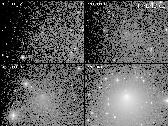2P/Encke

|
Periodic comet Encke has been observed through the most perihelion
passages of any comet seen by humans. This is partly due to the
comets record short orbital period, but also due to is relatively
high activity level (especially during its first observed
apparitions in the 18th and early 19th centuries) and its small
perihelion distance. It was first discovered by Pierre Mechain in
January 1786 and rediscovered 3 orbits later by Caroline Herschel
in 1795,
followed 3 orbits after that by Jean Louis Pons, Huth, and Bouvard
in 1805. The orbital period is about 3.3 years, so that every 3
orbits, or nearly 10 years, the comet returns to a similar
configuration with the Earth.
|
During its 1994 return to perihelion, I was able to obtain images
of the comet during each of 4 lunations before perihelion (which
occured on February 9, 1994) which show the rapid developement of
the comets coma.
I've combined them into a mosaic for easy comparison of the 4 images.
The 1993 October image shows only a faint coma
and a hint of a tail or dust trail towards about 2 o'clock - the
comet is nearly stellar in appearance. The
1993 November image shows a brighter coma and perhaps a tail towards
about 4 o'clock. The 1993 December image shows a fan shaped coma, but
the nuclear condensation has not significantly brightened. Finally,
the 1994 January image, taken about a month from perihelion shows a
huge increase in the comets activity with the nuclear region now
much brighter, a large coma and a tail or dust trail heading off
towards about the 1 o'clock position angle.
|
Last update: January 30, 1998

